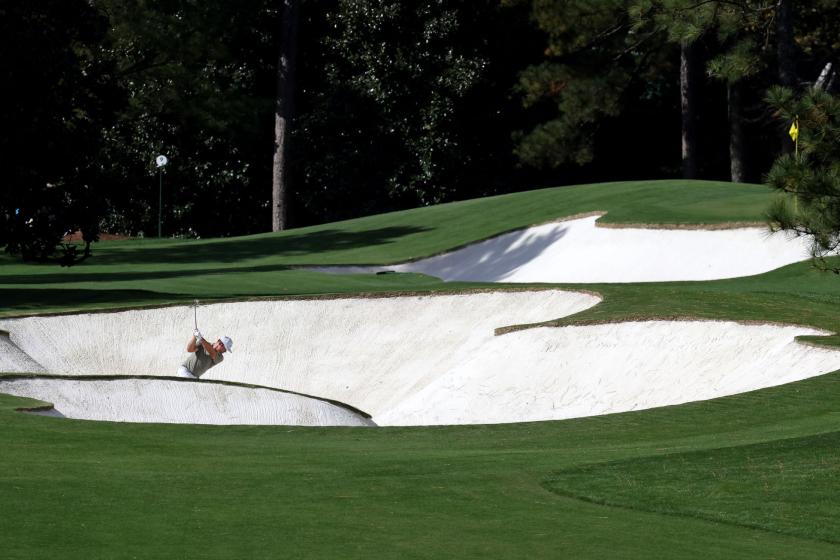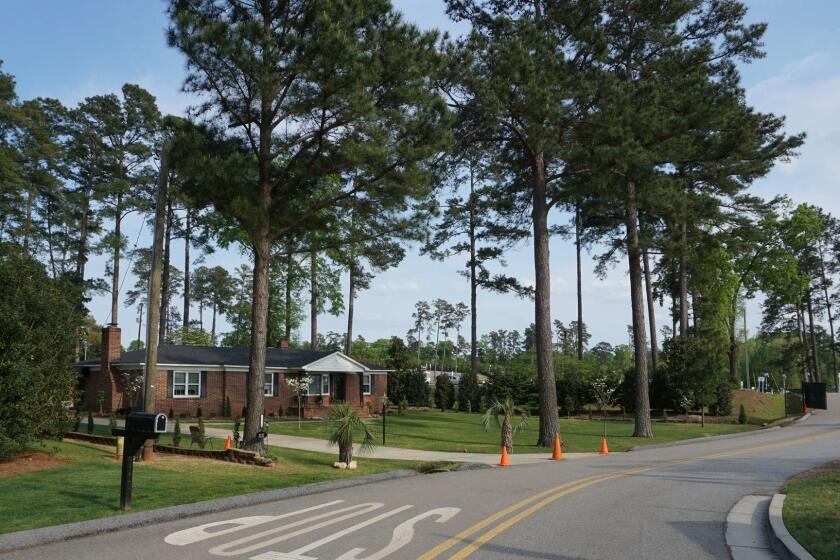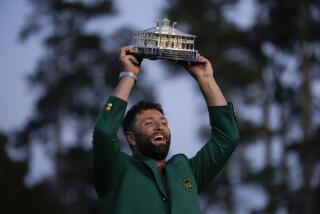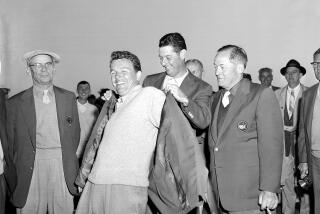A stay at the Crow’s Nest is a rite of passage for amateurs at Augusta National
- Share via
AUGUSTA, Ga. — If you’re a young, wide-eyed golfer fortunate enough to play your way into the Masters, you start at the top.
And the top is the Crow’s Nest.
That’s the cozy and neatly appointed attic of the clubhouse and a place even Augusta members seldom see. The 30-by-40-foot room provides living space for up to five amateurs playing in the tournament, and featuring an 11-foot, square cupola with windows on each side, the lofty tip reachable only by ladder.
“Being up in the Crow’s Nest was one of the best experiences,” said Bryson DeChambeau, a favorite in this year’s Masters. “Getting to sleep there at night and experience that as a tradition. That needs to keep going on and it’s a tradition unlike any other, and I feel like it’s something that every amateur needs to experience.”
Tiger Woods will attempt to defend his Masters title at an Augusta National that this time will have no patrons, ropes or azaleas in bloom.
A young Jack Nicklaus bunked there and discovered it wasn’t an all-you-can-eat operation.
During Phil Mickelson’s stay, he crept down the back staircase at night to steal a look at the champions locker room.
Even Augusta chairman Fred Ridley, who played in the Masters three times as an amateur, had his own Crow’s Nest hijinks.
“I was up there with Curtis Strange and I think Keith Fergus, maybe, and a couple other guys,” said Ridley, who stayed there in 1976 and ’77. “I probably shouldn’t say this, but I do remember, there’s a window in the Crow’s Nest that actually was operable that went out onto the roof. And Curtis and I went out and sat on the roof and watched the world go by. Now, could you imagine that happening today?”
As the tournament has become more buttoned-down, those windows are probably latched tight.
It looks like sand from a tropical beach, but the material gleaming from the bunkers at Augusta National actually comes from the mountains of North Carolina.
Now, a lot of the players look at staying in the Crow’s Nest as checking a box, something to be experienced, a one-night rite of passage at a club so steeped in tradition. Even the amateurs bring teams of people with them — a mental coach, a swing coach, a nutritionist — so a hotel or rented house makes more sense.
The Crow’s Nest is not devoid of somewhat modern amenities. It has air-conditioning, a small TV the size of a desktop computer monitor, a telephone and Wi-Fi. But nobody truly has his own room. It’s one big room with partitions and dividers creating three cubicles with one bed each, and a fourth with two beds. The sitting area has a sofa, chairs, and a game table where in the old days players would convene for bridge. There’s a full bathroom with two sinks, but no kitchen.
There’s green carpet, and white paneled walls that feature lots of framed pictures — color and black-and-white — of great players both as amateurs and Masters champions.
Often, there’s lots of activity on the two floors below, so the Crow’s Nest isn’t the quietest of accommodations. It’s accessible via a back staircase, though, so players don’t have to come through the clubhouse to get to their room.
“It’s been 30 years, and yet, I feel I still remember it well because of the memories that stay with you the first time that you come here,” said Mickelson, a three-time Masters champion. “Because you don’t know if it’s going to be the last time you come here. So you really take it in.
“The ability to stay on the grounds and to walk right down below and have the Champions locker room right there, I snuck in there, sure. You know, Gene Sarazen was still around, and I saw his locker, and some of the greats from the era that I didn’t even see guys play from, Byron Nelson and Sam Snead, they were alive when I was playing there, and they were there at the Champions Dinner, and you could hear them down below when they were congregating.”
The grass is undeniably greener on the other side of the fence.
Nicklaus, the tournament’s only six-time winner, hosted that many Champions Dinners. When he stayed in there in 1959, he unwittingly ran up an extra tab.
“We had Phil Rodgers, Deane Beman, Ward Wettlaufer, Tommy Aaron and myself,” Nicklaus said. “We stayed there. That’s not a very big place, if you happen to go look at it, for five guys. One bathroom, one shower. But we all stayed there, and of course Phil and I were the big eaters at the time.
“The amateurs had to be charged for their food, so they charged us a dollar for breakfast, a dollar for lunch and two dollars for dinner. Phil and I, generally speaking, would have two steaks at night, and they came to us after a couple nights, and they said, ‘Gentlemen, you’re abusing the thing by eating two steaks. We’re going to have to charge you $2 apiece.’ I said, ‘That’ll be quite all right.’”
Eating crow, redefined.
More to Read
Go beyond the scoreboard
Get the latest on L.A.'s teams in the daily Sports Report newsletter.
You may occasionally receive promotional content from the Los Angeles Times.














